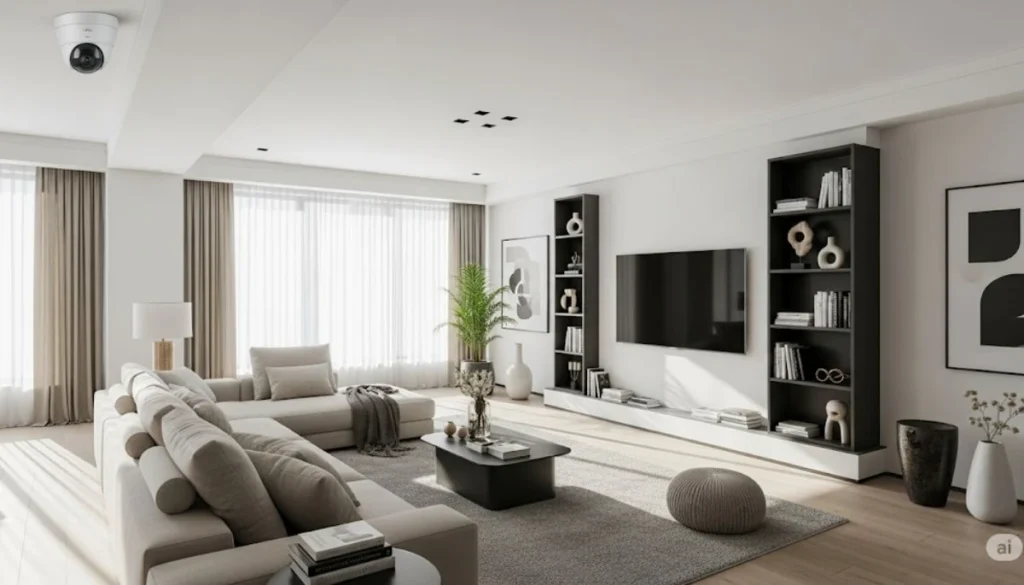Ever wondered if your home security cameras are catching all the action—or missing the mark? Placing cameras in the right spots can make the difference between a secure home and a blind spot for intruders.
Table of Contents
Let’s dive into the seven luckiest spots to ensure your home security camera works best, giving you peace of mind and top-notch protection.
Key Takeaways: Home Security Camera Placement Guide
| Topic | Takeaway |
|---|---|
| Best Camera Locations | Place cameras at high-priority spots: front door, back door, driveway, and common entry points. |
| Power Options | Choose between wired, battery-powered, or solar based on location and convenience. |
| Avoid These Spots | Do not install cameras in private areas (e.g., bedrooms) or places with legal/privacy risks. |
| Smart Integration | Compatible with Alexa, Google Assistant, and Apple HomeKit for smart control. |
| Wi-Fi Independence | Some cameras can record locally without Wi-Fi using SD cards or local storage. |
1. Entryways: Guard Your Front and Back Doors

Secure the main access points to deter intruders.
Entryways are prime targets for burglars, making them critical spots for home security cameras. Front and back doors should be monitored to capture anyone approaching or leaving.
- Camera Placement: Mount cameras 8–10 feet high, angled slightly downward to avoid glare and capture faces clearly.
- Camera Type: Use a video doorbell (e.g., Ring or Nest) or a wired home security camera for constant recording.
- Smart Features: Opt for cameras that work with Alexa, Google, or Apple HomeKit for real-time alerts on your phone or iPhone.
- Tip: Ensure the camera’s field of view (130–180°) covers the entire entryway without capturing neighbors’ property.
2. Driveways: Keep an Eye on Vehicles

Monitor your driveway for vehicle safety and visitor tracking.
Driveways are high-traffic areas, perfect for spotting deliveries or suspicious activity. A well-placed camera here ensures your home security camera works effectively.
- Camera Placement: Install at 7–9 feet, angled to cover the driveway and street edge without pointing at neighbors’ homes.
- Camera Type: Wireless home security cameras like the Arlo Pro 5S 2K, with battery power and solar panel options, offer flexibility.
- Power Options: Wireless cameras get power from rechargeable batteries or solar panels, while wired cameras ensure constant operation.
- Tool Tip: Use a free security camera layout planner like iSpy to map your driveway coverage.
3. Backyards: Protect Your Outdoor Space

Safeguard your backyard from intruders hiding in plain sight.
Backyards are vulnerable due to their seclusion, making them ideal for outdoor security camera placement.
- Camera Placement: Mount cameras under eaves or on fences, 8–10 feet high, to cover open areas and avoid bushes that block views.
- Camera Type: Choose weatherproof cameras (IP65 rating) like the Wyze Cam v4 for durability and color night vision.
- Wi-Fi Considerations: For cameras without Wi-Fi, opt for models like Reolink GO that use local storage (microSD) to keep recording.
- Smart Integration: Select cameras that work with 5GHz Wi-Fi for faster streaming or those compatible with your phone for easy monitoring.
4. Living Rooms: Monitor Indoor Activity

Keep tabs on your home’s central hub without compromising privacy.
Living rooms are high-traffic indoor areas, ideal for monitoring activity without invading personal spaces.
- Camera Placement: Place cameras in corners or on shelves for a wide field of view (70–130° for indoor settings).
- Camera Type: Compact indoor cameras like the Blink Mini 2 offer 1080p resolution and easy setup.
- Privacy Tip: Avoid areas with direct light or windows to prevent glare, which can cause a home security camera not working properly.
- Smart Features: Choose cameras that work with Google or Alexa for voice-controlled access via smart displays.
5. Main Stairways: Track Movement Between Floors

Capture movement in key transition areas of your home.
Stairways connect floors and are critical for monitoring indoor movement, especially in multi-story homes.
- Camera Placement: Mount at the top of stairs, angled to cover the entire staircase without obstructing pathways.
- Camera Type: Wired home security cameras like the Eufy Indoor Cam C120 provide reliable 24/7 recording.
- Power Options: Wired cameras ensure constant power, unlike wireless models that need periodic recharging.
- Tool Tip: Use an outdoor security camera placement tool like PlanIt2d to visualize stairway coverage.
6. Garages: Secure Your Vehicles and Tools

Protect valuable assets stored in your garage.
Garages often house cars, tools, and other valuables, making them a hotspot for security camera placement.
- Camera Placement: Install cameras in corners or above the garage door, 7–9 feet high, to monitor entry and contents.
- Camera Type: Opt for cameras with local storage (e.g., Lorex) for setups where home security cameras work without internet.
- Smart Features: Cameras that work with iPhone or Google apps allow remote access for quick checks.
- Tip: Ensure cameras have night vision to capture clear footage in low-light garage conditions.
7. Ground-Floor Windows: Cover Vulnerable Entry Points

Secure windows to prevent break-ins.
Ground-floor windows are common entry points for intruders, making them essential for camera coverage.
- Camera Placement: Mount cameras 8–10 feet high, angled to cover windows without facing directly at them to avoid glare.
- Camera Type: Wireless cameras like the SimpliSafe Smart Alarm offer AI motion detection and easy installation.
- Wi-Fi Considerations: For homes without 5GHz Wi-Fi, choose cameras that work with 2.4GHz or offline via microSD cards.
- Privacy Note: Avoid pointing cameras at neighbors’ windows to comply with privacy laws.
Types of Security Cameras for Home
Choose the right camera for your needs.
Understanding the types of security cameras for home use helps you select the best fit for each spot.
| Type | Features | Best For |
|---|---|---|
| Wired Cameras | 24/7 recording, reliable power, high-quality video (e.g., Eufy C120) | Entryways, stairways, garages |
| Wireless Cameras | Battery/solar-powered, flexible placement (e.g., Arlo Pro 5S) | Driveways, backyards, windows |
| Video Doorbells | Motion detection, two-way audio (e.g., Ring Doorbell) | Front doors |
| Hidden Cameras | Discreet, compact (e.g., Blink Mini) | Living rooms, stairways |
| Floodlight Cameras | Bright lighting, wide coverage (e.g., Eufy Floodlight E340) | Backyards, driveways |
Where Not to Install Security Cameras
Avoid these spots to respect privacy and ensure legality.
Certain areas should be off-limits to prevent legal issues and maintain privacy.
- Bedrooms and Bathrooms: These areas have a high expectation of privacy, and cameras here may be illegal.
- Neighbor’s Property: Pointing cameras at neighbors’ homes or yards can violate privacy laws.
- Windows Facing Out: Cameras aimed at windows often suffer from glare, reducing effectiveness.
- Low or Accessible Spots: Avoid placing cameras within reach to prevent tampering.
How Do Home Security Cameras Work Without Wi-Fi?

Keep your cameras running offline.
Many cameras can function without Wi-Fi, ideal for areas with poor connectivity.
- Local Storage: Cameras like Reolink or Lorex store footage on microSD cards or DVR/NVR systems.
- Analog Cameras: These record directly to a hard drive, bypassing internet needs.
- LTE Options: Cameras like the Ezviz EB8 4G use cellular networks for remote access.
- Tip: Check storage capacity (e.g., 128GB microSD) to ensure sufficient recording time.
Smart Home Integration
Enhance your setup with smart features.
Modern cameras integrate with smart home systems for seamless control.
- Alexa/Google: Cameras like Ring or Nest work with Alexa or Google Assistant for voice commands and smart display viewing.
- Apple HomeKit: Look for HomeKit-compatible cameras (e.g., Eufy) for iPhone integration.
- Phone Apps: Most cameras offer apps for real-time monitoring on your phone or iPhone.
- Tip: Ensure cameras support 5GHz Wi-Fi for faster streaming, if available.
FAQs
How many cameras do I need for a typical home?
For a standard home, 4–6 cameras are sufficient, covering entryways, driveways, backyards, and key indoor areas. Adjust based on home size and layout.
Can I use indoor cameras outdoors with protection?
Indoor cameras aren’t weatherproof (no IP65 rating), so they’re not recommended outdoors, even with covers, due to moisture and temperature risks.
How often should I check my camera’s footage?
Review footage weekly or after alerts to ensure cameras are working and storage isn’t full. Set up real-time notifications for efficiency.
What’s the best resolution for home security cameras?
2K or 4K cameras (e.g., Arlo Pro 5S) offer sharper details than 1080p, ideal for identifying faces or license plates.
How do I protect my cameras from hacking?
Use strong passwords, enable two-factor authentication, and keep firmware updated. Place cameras on a separate network for added security.
Conclusion
Placing your home security cameras in the right spots—entryways, driveways, backyards, living rooms, stairways, garages, and ground-floor windows—ensures comprehensive coverage.
Choose the right camera type, avoid privacy-sensitive areas, and leverage smart features like Alexa or Apple HomeKit integration for a seamless experience. Use free tools like iSpy or PlanIt2d to plan your layout and ensure your home security camera works best. Start optimizing your setup today for ultimate peace of mind!
Related Post You May Like















